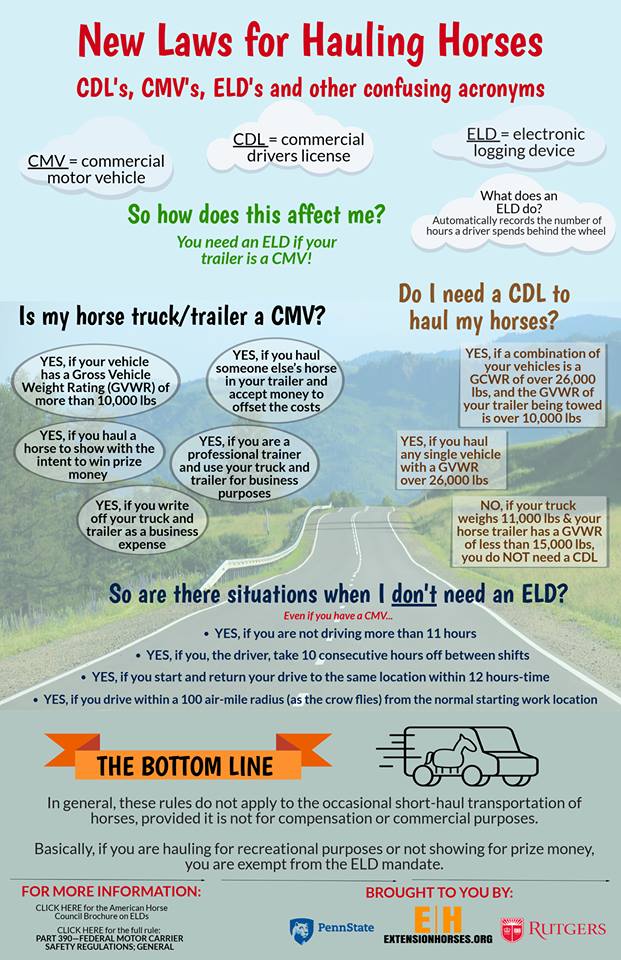Dec 6, 2017 – Note recent article links added below.
Courtesy of The Chronicle of the Horse – Electronic Logging Device Mandate: How Will It Impact Equestrians? by Kimberly Loushin
With the Dec. 18 deadline for commercial vehicles to be equipped with an electronic logging device, or ELD, fast approaching, concerns have risen in the equestrian community about how the mandate will affect them. An ELD is a device on a vehicle that connects to the engine and automatically monitors the time an engine is running and the mileage it’s driven.
The mandate is part of the 2012 Moving Ahead For Progress In The 21st Century bill or MAP-21, which required the Federal Motor Carrier Safety Administration to mandate the use of ELDs on commercial vehicles. In December of 2015, the final rule was published, and a two-year awareness and transition phase began, where drivers were encouraged to make the transition from paper logbooks and other logging software to the ELD.
The rule impacts drivers who are already required to keep a log of their driving hours. The intent of the device is that when a commercial vehicle is stopped, there is an accurate record of how long the driver has been on the road. As it stands, drivers have a 14-hour work period, while only 11 of those hours can be spent actually driving. Once that time has expired, drivers have a mandatory 10-hour break before they can resume driving.
The biggest problem in the horse industry arises when there is a delay in loading the truck.
“The way it’s going to affect us mostly is when we go in to pick up at these shows,” said Jack Williams, a driver for Beacon Hill Transportation. “You go to a horse show, and they tell you 3 o’clock and you know how horse shows go, they get more entries, drag breaks are longer, and they hold you up for three or four hours. Then you could run into a problem at the other end and not be able to get back to the farm or get back to the yard. That’s going to be the biggest problem. That and the one-day shows where you sit all day and you have to wait for the horses and then go back to the farm and then get back to your yard.”
In this scenario, though the driver is not actively working, his time clock is still running and his window to get the horses dropped off—and his rig back to the yard—has decreased. One solution would be to add a second driver, however with increased personnel comes increased cost.
The American Horse Council has requested a year delay for the equine industry to come into compliance and is simultaneously advocating for specific exemptions for the horse industry. One of these exemptions would be a split sleeping berth exemption.
“That exemption would allow for drivers to alternate throughout the day at intervals of their choosing. It wouldn’t be 10 hours on, 10 hours off,” said Cliff Williamson, director of heath and regulatory affairs at the American Horse Council. “It could be five hours on, five hours off, five hours on, five hours off. We’re hauling live animals, so we can’t allow drivers to stop at a truck stop [to rest for extended periods]. We can’t justify having truckers pull over on the side of the road just to keep their books in order.”
The Department of Transportation has also proposed a 150-air mile exemption, which says that as long as the trailer trip is within that 150-air-mile range, it won’t have to be reported. (An air-mile is a straight-line distance between Point A and Point B.)
The DOT has verbally agreed to a 90-day extension for the agricultural industry, however that extension has not been officially passed.
The ELD mandate has also raised concerns about whether people outside of commercial hauling companies will be impacted. Truck-and-trailer combinations with a gross vehicle weight over 26,000 pounds are required to have a driver with a commercial driver’s license; a CDL is also required if the the purpose of the vehicle is deemed commercial. The American Horse Council suggests reaching out to the FMCSA or the DOT, to ensure that you’re in compliance.
“The frustration is that enforcement of the rules depends on the state that you’re in,” said Williamson. “Federal rules apply to everybody, but Ohio might enforce those rules differently than Michigan. And then it can be different from county to county, so that makes it very, very hard to tell horse owners how to comply with the rule. Rule of thumb is to be over-certified and everything else just makes you a safer driver. We encourage anybody driving large vehicles to look into their local regulations and their state regulations and make a good decision based on the vehicle and how often they travel.”
Click to view the AHC Electronic Logging Device Mandate ‘How Will It Affect You?’ brochure.
Click to read Jan 3, 2018 Tri-State Livestock News www.tsln.com
Click to read about extension to March 18, 2018 www.euiery.com
Click to read how the ELD mandate will impact the horse industry.
Click to read Dec. 20th article on www.useventing.com
Click to read article on www.chronofhorse.com
Click to read more with American Horse Council
Consider showing your support by joining AHC today.
Click to read the ECFR mandate.



